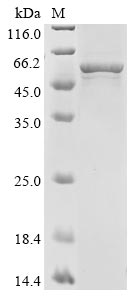Expressing the recombinant human aromatase (CYP19A1) protein generally involves constructing a plasmid encoding the human CYP19A1 protein (1-503aa) and the N-terminal 6xHis-tag. This plasmid is introduced into E.coli cells, followed by the selection and culturing of positive E.coli cells, induction of protein expression, and subsequent cell lysis. The recombinant human CYP19A1 protein is purified through affinity purification, and SDS-PAGE analysis is conducted to confirm the presence of the protein and determine its purity. This protein exhibits a purity exceeding 85%.
CYP19A1 is an important enzyme in making estrogen. It helps convert androgens into estrogens, which is crucial for regulating hormones and keeping the body functioning smoothly [1]. This enzyme is found in different tissues like the ovaries, placenta, fat tissue, testes, and certain parts of the brain [2]. Its job isn't just about making estrogen; it also affects cell growth and hormone release [3][4]. Plus, CYP19A1 has links to health issues like endometriosis, infertility, and cancer [5][6][7]. Researchers have found that factors like microRNAs, gene variations, and chemical marks on DNA can all mess with how much CYP19A1 we have, affecting hormone levels and disease risks [8][9]. And it's not working alone; other proteins like Foxl2 and NR5A1 help regulate its activity [4][10]. In studies on cells from ovaries, changes in the CYP19A1 gene altered how the cells behaved [11]. Plus, when the androgen receptor isn't working right, it can throw off CYP19A1's activity, showing how different hormones can interact [12]. All in all, CYP19A1 does a lot—it's not just about making estrogen, but it's also deeply involved in reproductive processes and the development of certain health conditions.
References:
[1] S. Parween, G. Nardo, F. Baj, C. Zhang, G. Gilardi, & A. Pandey, Differential effects of variations in human p450 oxidoreductase on the aromatase activity of cyp19a1 polymorphisms r264c and r264h, The Journal of Steroid Biochemistry and Molecular Biology, vol. 196, p. 105507, 2020. https://doi.org/10.1016/j.jsbmb.2019.105507
[2] M. Alves, M. Almeida, A. Oliani, L. Breitenfeld, & A. Ramalhinho, Cyp19a1 tc/cc polymorphism, along with deletion of gstm1 and gstt1 genes, strongly influences female infertility risk, Antioxidants, vol. 12, no. 4, p. 940, 2023. https://doi.org/10.3390/antiox12040940
[3] X. Lu, A. Duan, X. Ma, S. Liang, & T. Deng, Knockdown of cyp19a1 in buffalo follicular granulosa cells results in increased progesterone secretion and promotes cell proliferation, Frontiers in Veterinary Science, vol. 7, 2020. https://doi.org/10.3389/fvets.2020.539496
[4] A. Dai, H. Sun, T. Fang, Q. Zhang, S. Wu, Y. Jianget al., Microrna‐133b stimulates ovarian estradiol synthesis by targeting foxl2, Febs Letters, vol. 587, no. 15, p. 2474-2482, 2013. https://doi.org/10.1016/j.febslet.2013.06.023
[5] C. Zhang, Y. Cheng, W. Chen, Q. Li, R. Dai, Y. Wanget al., Association of cyp19a1 rs28757157 polymorphism with lung cancer risk in the chinese han population, World Journal of Surgical Oncology, vol. 20, no. 1, 2022. https://doi.org/10.1186/s12957-022-02868-9
[6] I. Barcelos, F. Donabella, C. Ribas, J. Meola, R. Ferriani, C. Pazet al., Down-regulation of the cyp19a1 gene in cumulus cells of infertile women with endometriosis, Reproductive Biomedicine Online, vol. 30, no. 5, p. 532-541, 2015. https://doi.org/10.1016/j.rbmo.2015.01.012
[7] F. Al-Mukaynizi, M. Alanazi, S. Al-Daihan, N. Parine, M. Almadi, A. Aljebreenet al., <em>cyp19a1</em> gene polymorphism and colorectal cancer etiology in saudi population: case&ndash;control study, Oncotargets and Therapy, vol. Volume 10, p. 4559-4567, 2017. https://doi.org/10.2147/ott.s121557
[8] Y. Yu, C. Sun, Y. Liu, Y. Li, L. Wang, & W. Zhang, Promoter methylation of <b><i>cyp19a1</i></b> gene in chinese polycystic ovary syndrome patients, Gynecologic and Obstetric Investigation, vol. 76, no. 4, p. 209-213, 2013. https://doi.org/10.1159/000355314
[9] M. Alanazi, H. Alabdulkarim, J. Shaik, A. Naeem, M. Elrobh, A. Amriet al., No associations between aromatase gene polymorphisms and breast cancer risk in saudi patients, Oncotargets and Therapy, p. 2453, 2015. https://doi.org/10.2147/ott.s84696
[10] B. Yilmaz and S. Bulun, Endometriosis and nuclear receptors, Human Reproduction Update, vol. 25, no. 4, p. 473-485, 2019. https://doi.org/10.1093/humupd/dmz005
[11] Y. Zhang, X. Chen, Z. Zhou, X. Tian, P. Yang, & K. Fu, Cyp19a1 may influence lambing traits in goats by regulating the biological function of granulosa cells, Animals, vol. 12, no. 15, p. 1911, 2022. https://doi.org/10.3390/ani12151911
[12] M. Lopez, Androgen receptor deficiency is associated with reduced aromatase expression in the ventromedial hypothalamus of male cichlids, Annals of the New York Academy of Sciences, vol. 1532, no. 1, p. 73-82, 2024. https://doi.org/10.1111/nyas.15096






